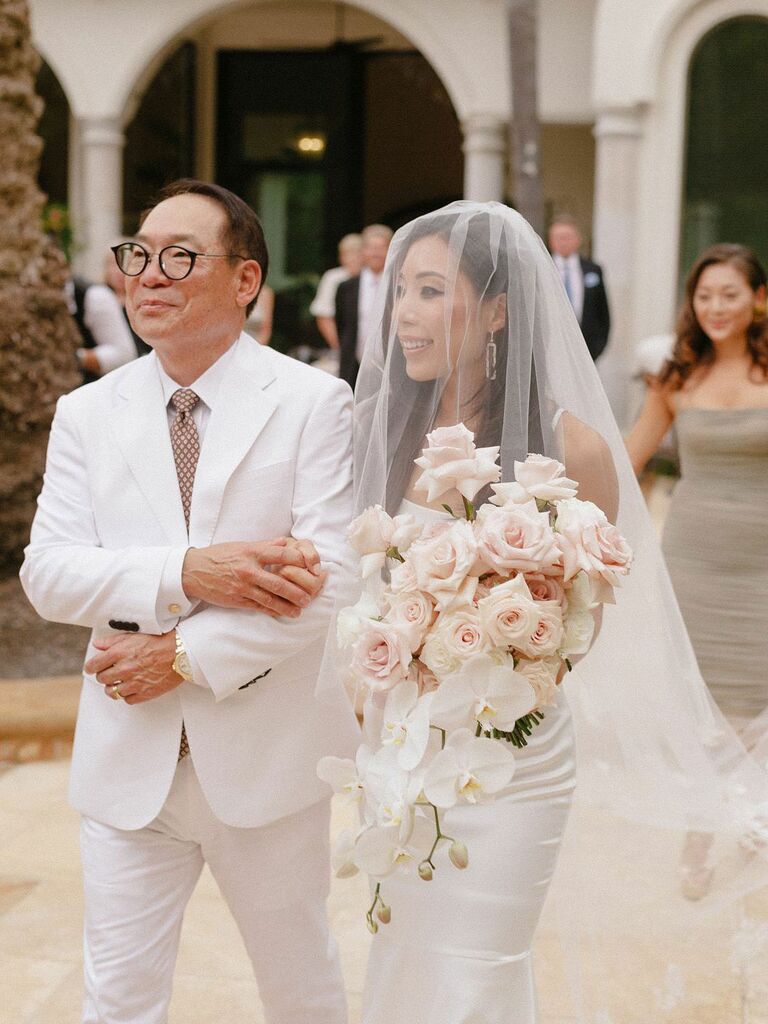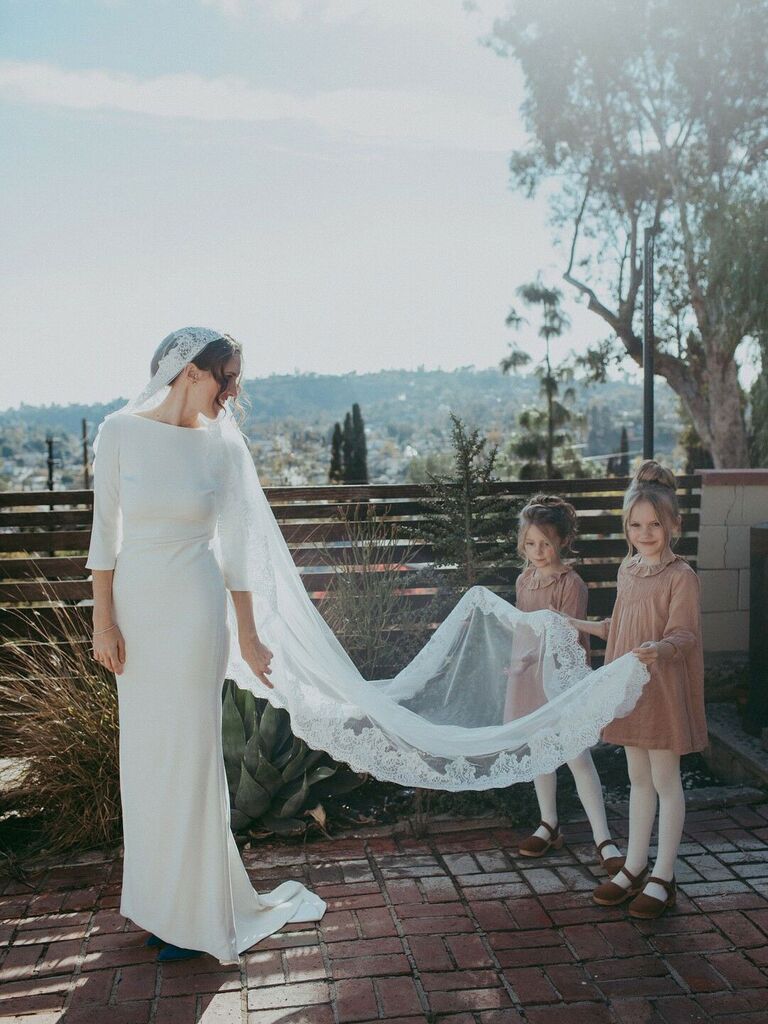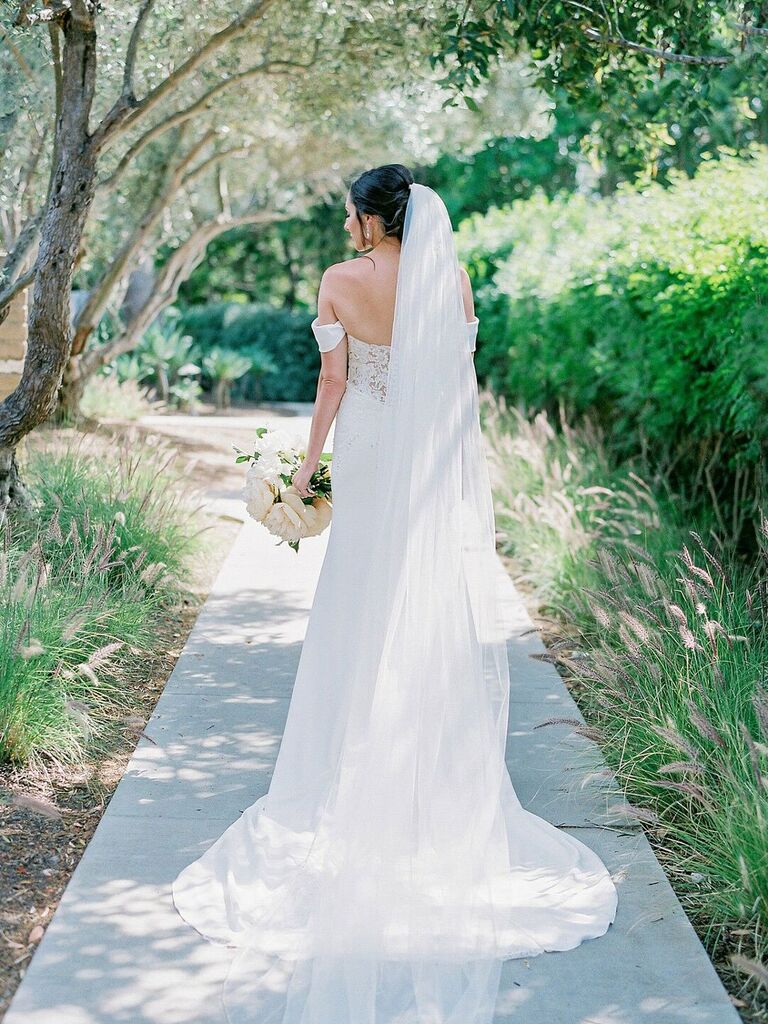White Wedding Dress White Veil Over Her Face
Does it have to cover your face? And how long should it be? Find out here.
It's no secret that weddings are laced with tradition and symbolism—and as you plan your big day, you might wonder if you need to follow common wedding rules. One question you might have, especially if you'll be wearing a wedding dress, is whether or not you need to wear a veil as well. This popular fashion accessory is rooted in historical significance. But, if you're not sure of the true wedding veil meaning and etiquette, you might be conflicted as to whether or not you want to wear one as you walk down the aisle. To help you decide on your wedding day outfit, we tapped industry experts to share everything you need to know about the wedding veil meaning. You'll also find answers to common questions, like if your veil has to go over your face, how long it should be, and whether or not it should match your dress. Brush up on wedding veil tradition here, and use these expert tips to plan an outfit that makes you feel like your very best self.
What's the original wedding veil meaning?

Wedding veils are deeply rooted in tradition and history. Today, some brides simply opt to wear one because it gives an effortless bridal look. The original wedding veil meaning, though, can be traced back centuries and is often related to purity and modesty. "Wedding veils are one of the most historic pieces of the bridal ensemble, and the tradition is said to have arisen from the ancient Greeks," says Megan Ziems, founder of Grace Loves Lace. "Historically, veils were used to represent modesty and purity in religious ceremonies, however, the meaning has since evolved. Now, veils are seen as a modern accessory to help capture the true essence and personal style of each and every bride."
Some even say the meaning of veils can be traced back to warding off bad energy and hiding the bride from her fiancé as they met at the altar. "Historically, it was thought that the veil kept away evil spirits," says wedding dress designer Madeline Gardner. "It was also so that the bride's face was hidden."
If this wedding veil tradition doesn't resonate with you, there's no need to wear one on your big day. But, you can also add a veil to your look just because you like the look of it—not because of its original meaning.
Do you need to wear your veil over your face?

Given its original meaning, you might wonder if your wedding veil should be covering your face as you walk down the aisle—and the decision is completely up to you. While you can drape it over your head to create an aura of mystery, you can also leave your veil flipped over your head or tucked under your hairstyle. (That way, everyone will see your smiling face as you walk down the aisle to your S.O.) If you're not concerned with following wedding veil tradition, you can wear your headpiece however you please.
"Your veil doesn't have to cover your face," says Laurie Underwood, founder of Laury Bride. "It depends on how you want to feel. If you want to be mysterious and feminine, let your partner pull your veil back at the altar. Otherwise, you can simply wear it as an accessory that styles the back of your gown." Adds Gardner: "Having a veil cover your face is a very personal choice. Just like gowns, there are so many options to choose from."
Does your veil need to match your dress?

Wedding fashion is all about showing off your personality and your creativity. Since to-be-weds are encouraged to wear what makes them feel their best, you might wonder if the veil needs to match the dress. As with most other fashion decisions, your wedding day styling is up to you. While experts recommend choosing a veil that corresponds with the vibe of your dress or your wedding theme, there really are no rules when it comes to picking the perfect headpiece. "Ultimately, the styling is up to the bride," says Underwood. "Having a veil that coordinates with the dress will help bring the entire look together, so be mindful of the materials and colors used when searching for your veil. Doing so will ensure they both complement each other."
How long should a wedding veil be?

One of the most important components of your veil is its length. While you can opt for something long, like a cascading veil à la Meghan Markle, it's not your only choice. In fact, there are plenty of shorter styles that might be the perfect finishing touch for your dress. "From cathedral length to fingertip veil or vintage blushers and birdcage veils, there are plenty of options to complete any look you're going for," says Gardner.
There are no specific requirements that dictate how long a wedding veil should be, so you can get creative with the style you choose. Keep in mind, though, that a longer, delicate veil will require special care and prep before (and after) your wedding day to avoid damage or wrinkles. And, if you'll be saying "I do" outdoors, windy conditions might disrupt a perfectly arranged long veil. (In this case, we suggest tasking your maid of honor with keeping it in place as best as possible during your vows.)
No matter the length of your veil, collaborate with your hairstylist or glam team to make sure it's securely fastened before you head down the aisle to avoid any style mishaps. "No matter which veil, headpiece or hair accessory you opt for, make sure it is securely fastened to avoid any surprises," advises Ziems. "We recommend working with your hairstylist ahead of time to ensure your accessory is locked in on the wedding day."
If you do choose to wear a veil, opt for one that makes you feel your best, whether it's an eclectic blusher or an ethereal cathedral veil. Wearing an outfit that enhances your style will help your confidence shine through on your wedding day—and that's the best accessory you can have.
Source: https://www.theknot.com/content/does-the-veil-have-to-cover-my-face
0 Response to "White Wedding Dress White Veil Over Her Face"
Post a Comment